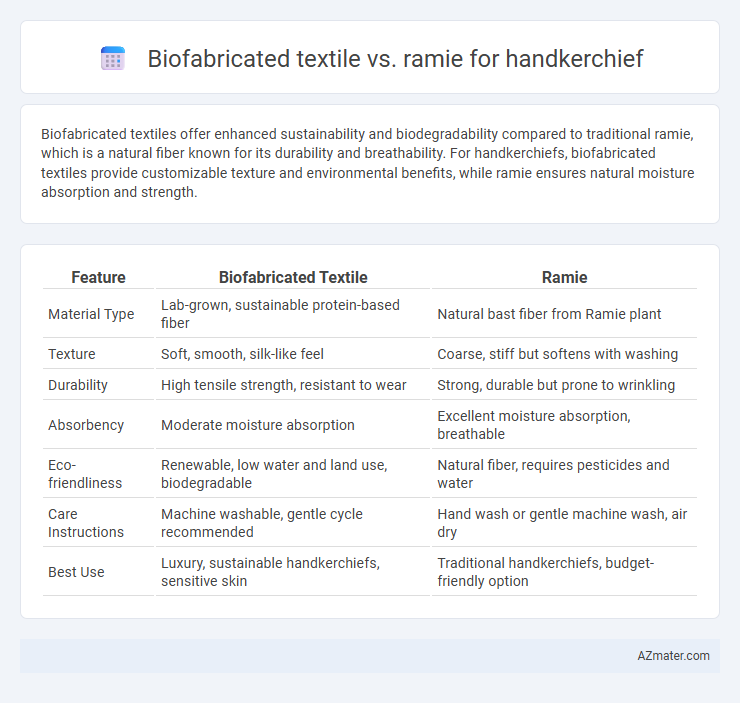Biofabricated textiles offer enhanced sustainability and biodegradability compared to traditional ramie, which is a natural fiber known for its durability and breathability. For handkerchiefs, biofabricated textiles provide customizable texture and environmental benefits, while ramie ensures natural moisture absorption and strength.
Table of Comparison
| Feature | Biofabricated Textile | Ramie |
|---|---|---|
| Material Type | Lab-grown, sustainable protein-based fiber | Natural bast fiber from Ramie plant |
| Texture | Soft, smooth, silk-like feel | Coarse, stiff but softens with washing |
| Durability | High tensile strength, resistant to wear | Strong, durable but prone to wrinkling |
| Absorbency | Moderate moisture absorption | Excellent moisture absorption, breathable |
| Eco-friendliness | Renewable, low water and land use, biodegradable | Natural fiber, requires pesticides and water |
| Care Instructions | Machine washable, gentle cycle recommended | Hand wash or gentle machine wash, air dry |
| Best Use | Luxury, sustainable handkerchiefs, sensitive skin | Traditional handkerchiefs, budget-friendly option |
Introduction to Sustainable Handkerchief Materials
Biofabricated textiles offer a cutting-edge sustainable alternative to traditional fibers like ramie for handkerchiefs, utilizing lab-grown materials that reduce environmental impact through lower water and pesticide use. Ramie, a natural bast fiber derived from the stalks of the Boehmeria plant, boasts biodegradability, high tensile strength, and excellent moisture absorption, making it a popular eco-friendly choice. Comparing biofabricated textiles and ramie highlights innovations in sustainability, durability, and softness for environmentally conscious handkerchief production.
What is Biofabricated Textile?
Biofabricated textile is an innovative material produced through microbial fermentation or cell culture processes that mimic natural fiber development without relying on traditional farming or harvesting. Unlike ramie, a natural plant-based fiber known for its strength and smooth texture, biofabricated textiles offer sustainable and scalable production with reduced environmental impact. These textiles can be custom-engineered for specific properties such as softness, durability, and biodegradability, making them a promising alternative for handkerchief manufacturing.
Understanding Ramie: An Ancient Fiber
Ramie, an ancient fiber derived from the stalks of the Boehmeria plant, is renowned for its natural luster, strength, and breathability, making it a durable choice for handkerchiefs. Biofabricated textiles, engineered through advanced biotechnology, offer enhanced sustainability and customizable properties but often lack the traditional texture and heritage of ramie. Understanding ramie's long-standing use in textiles highlights its eco-friendly cultivation with minimal pesticides and its superior moisture-wicking ability, which remain relevant for sustainable handkerchief production.
Production Process: Biofabrication vs Ramie Cultivation
Biofabricated textiles are created through a controlled fermentation process using microbial cultures to produce fibers with minimal environmental impact, bypassing traditional agriculture. Ramie cultivation relies on labor-intensive farming, involving planting, harvesting, and chemical retting to extract fibers from the ramie plant stems. The biofabrication process offers faster, more consistent fiber production with reduced water and pesticide use compared to the resource-demanding cultivation and processing of ramie.
Environmental Impact Comparison
Biofabricated textiles, produced through microbial fermentation, significantly reduce water consumption and land use compared to ramie, a traditional plant-based fiber requiring extensive agricultural resources and pesticide application. Ramie cultivation contributes to soil degradation and chemical runoff, while biofabricated textiles generate biodegradable materials with lower greenhouse gas emissions. This environmental impact comparison highlights biofabricated textiles as a more sustainable choice for handkerchief production, minimizing ecological footprint and resource depletion.
Texture and Comfort: User Experience
Biofabricated textiles offer a consistently smooth and soft texture, enhancing handkerchief comfort by reducing skin irritation and improving moisture absorption. Ramie fibers provide a natural crispness and breathability, contributing to a lightweight and durable handkerchief but can feel slightly coarse compared to biofabricated alternatives. Users often experience biofabricated handkerchiefs as gentler on sensitive skin, while ramie handkerchiefs excel in strength and longevity.
Durability and Longevity Differences
Biofabricated textiles exhibit superior durability and longevity compared to traditional Ramie fibers due to their engineered molecular structure that resists wear and environmental damage. Ramie, while naturally strong and moisture-absorbent, tends to degrade faster under repeated washing and prolonged exposure to sunlight. The synthetic precision in biofabricated textiles ensures maintained integrity, making them a more resilient choice for handkerchief applications.
Cost Analysis: Affordability and Accessibility
Biofabricated textiles typically incur higher production costs due to advanced biotechnological processes, making them less affordable than conventional ramie fibers for handkerchiefs. Ramie, a traditional natural fiber, benefits from established supply chains and lower raw material expenses, resulting in more accessible price points for consumers. Cost analysis highlights that while biofabricated textiles offer innovation and sustainability, ramie remains the economically viable option in mass-market handkerchief production.
Biodegradability and End-of-Life Considerations
Biofabricated textiles demonstrate superior biodegradability compared to ramie, decomposing rapidly without releasing harmful residues, which significantly reduces environmental impact. Ramie, a natural fiber, is biodegradable but tends to decompose more slowly and may require specific conditions to break down efficiently. End-of-life considerations favor biofabricated textiles for handkerchiefs due to their compatibility with circular economy practices, enabling easier composting or recycling compared to traditional ramie fibers.
Choosing the Right Material for Eco-Friendly Handkerchiefs
Biofabricated textiles offer a sustainable alternative to conventional materials, providing biodegradability and reduced environmental impact compared to ramie, which is a natural plant fiber known for its durability and moisture-wicking properties. Ramie handkerchiefs are breathable and resistant to bacterial growth, making them suitable for everyday use, while biofabricated textiles often incorporate innovative production methods that minimize water usage and chemical treatments. Choosing the right material depends on prioritizing eco-friendliness, with biofabricated textiles emphasizing cutting-edge sustainability and ramie highlighting traditional natural fiber benefits.

Infographic: Biofabricated textile vs Ramie for Handkerchief
 azmater.com
azmater.com